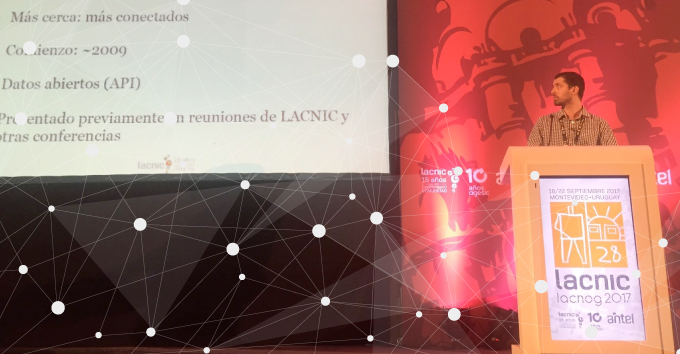LACNIC Measures Network Interconnection in Latin America and the Caribbean
30/01/2018

Agustín Formoso, a researcher who began his career at LACNIC and who will soon begin working at RIPE NCC, led the Simón project to measure Internet latency in Latin America and the Caribbean and thus be able to infer the state of regional interconnection among the networks in the LACNIC service region.
The initiative has been collecting latency measurements in the region since 2012 and offers information to the entire Internet community regarding the state of network interconnection in the LACNIC territories. Simón provides a permanent X-ray of how networks are connected in Latin America and the Caribbean.
Formoso explained that the measurements collected by the project allow determining the efficiency of the Internet and how efficiently users can access the services hosted on each network. Simón is among the first to have an overview of what regional interconnection looks like, explained Formoso.
The researcher noted that results depend on which measurement platform is used.
In the case of Simón, three different measurement platforms are used to gather data: RIPE Atlas (which has 1% penetration in the LACNIC region and is the preferred option as it is a very robust platform), a commercial platform called SpeedChecker (a virtual software which is installed on laptop computers and has penetration of 13% in the region), and a small JavaScript probe (with 42% penetration in the area measured by the Simón project).
According to Formoso, the first two were existing platforms, while the third is a probe developed by LACNIC that offers more measurement points, especially in the case of developing regions such as LACNIC.
Data from the third platform is not comparable with that of the first two. It can offer a high-level overview of how users perceive quality, but it cannot be compared with the other two.
Country Clusters. This research measured latency in 3,500 networks throughout Latin America and the Caribbean. A comparison of the latest two full snapshots obtained (2016 vs 2017) shows progress and improvements. Results of this comparison were presented during the past LACNIC28/LACNOG 2017 meeting (http://bit.ly/2B6dwZo)
“While there were no disruptive changes, we saw slight improvements in latency levels, particularly in cross-country connections. The highest latencies occur when users of one country access services located in another (e.g., a user in Uruguay accessing services in Argentina), and that is where we noticed improvement. Measurements within the same country have remained at similar levels,” observed Formoso.
Based on this latency data, the project conducted a study of clusters grouping countries which exhibit better interconnection. “Some countries are better interconnected among themselves than with others; in these cases, the influence of geographical proximity is clearly visible. We also tried to identify patterns and see if we could develop recommendations for those who were not well connected,” the researcher added.
An analysis of the results showed higher latency values in the clusters having greater surface area, an indication that the geographical component is very strong. Thus, absolute latency values were relativized by introducing the geographic variable. The result showed an improvement for such large clusters. “We realized, for example, that high levels of latency are justified in the Southern Cone because the cluster is so large. By introducing the geographic component, we were able to relativize those values and see that, considering its size, the latency values measured in the cluster are good,” said Formoso.
The data obtained through the Simón project is open and the idea is that each operator will look at the results, do some research, and help improve latency and regional interconnection. This is one of the research projects carried out by LACNIC aimed at helping improve the Internet in the region through measurements and analysis.
More information on the Simón Project: https://simon.lacnic.net/
(Free access, no subscription required)